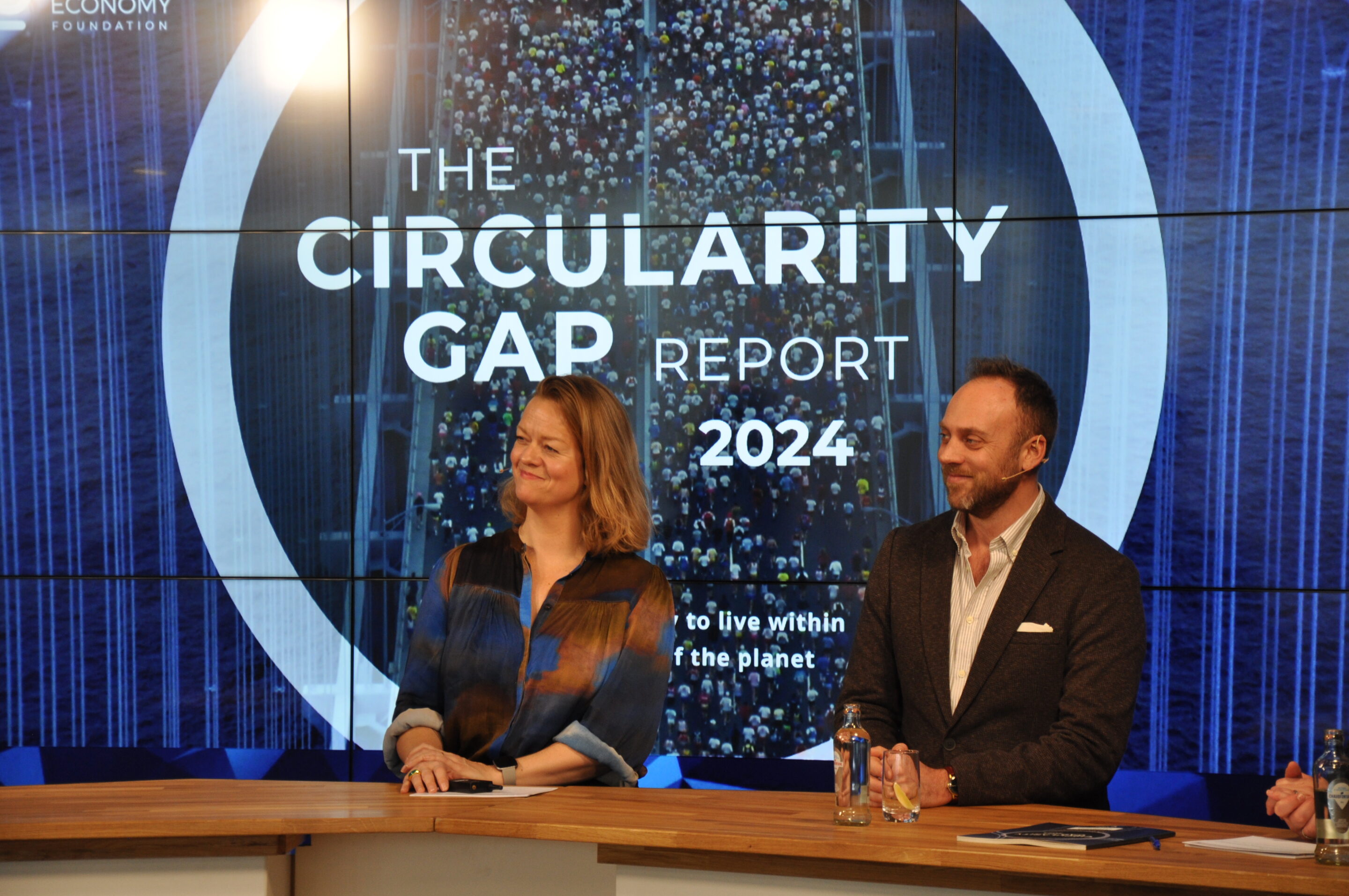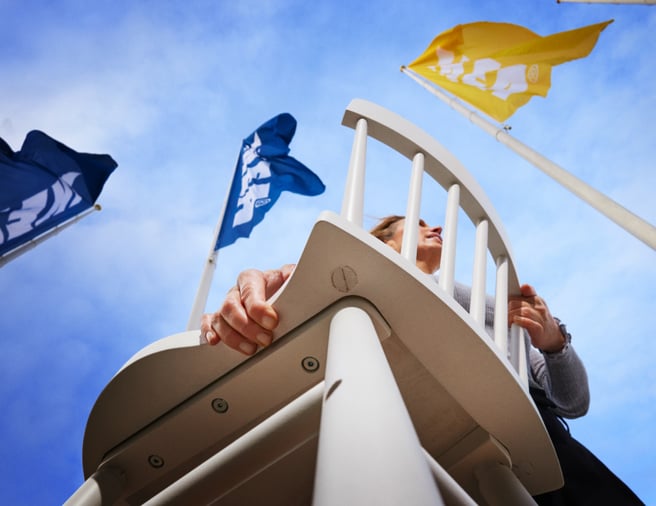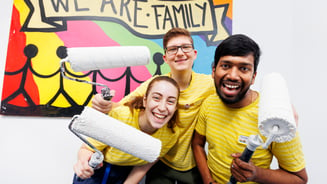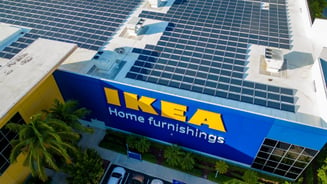A bold call for rewiring linear systems into regenerative, affordable models.
In this candid conversation, Ingka Group’s Circular Leader, Hege Sæbjørnsen, reflects on ten years of driving sustainability at scale – from her roots in social innovation to shaping systems change with impact, affordability, and human behaviour at the core. We explore the realities of shifting from linear to circular, the tension between personal values and business goals, and how IKEA is helping make sustainable living not just possible – but simple and affordable.
In episode 1 of this new series of recorded discussions, Hege shares insights on making sustainable living part of everyday life. A conversation on circularity, systems change and what’s possible.

 Hege Sæbjørnsen at a presentation of Circularity Gap Report 2024 Launch event, Amsterdam.
Hege Sæbjørnsen at a presentation of Circularity Gap Report 2024 Launch event, Amsterdam.
Full transcript available below:
So hello, I’m Kat and with me today I have Hege, our Circular Leader.
Thank you for joining me. Thank you for having me.
And today, or is it this week, is your ten-year anniversary here at IKEA?
It was the 27th of April this year. But I received my ten-year IKEA silver Allen key pin the other day. So that was a good moment to celebrate and reflect on the ten years I’ve been with IKEA.
And how did you end up here? Did you always want to work for IKEA?
Good question. Yeah. Short story of that, I guess. I joined in the UK and Ireland, although I’m Norwegian – Hege sort of gives it away – I lived in the UK for 29 years. I came from a background originally as a photographer, and maybe we can talk about that in a different context, but I had a few years in social innovation and the impact startup space. One of the questions that came to me more and more, particularly when I worked on social innovation and social entrepreneurship, was that this needs to scale, it needs to get outside the bubble. Then the thought was, where do you scale good, sustainable business? And IKEA came up as a bit of an opportunity. But growing up in Norway, IKEA was always in my life as a brand. I didn’t expect to work for IKEA, but it turned out to be a really good fit.
So you went into the creative field initially?
Yes.
And then how did you end up in circular in particular?
Yeah, that’s a big question that I can try to respond to with a short story. I could give you the 50-second answer or a very long one, depending on how long we have. I was fortunate to go to the UK to study arts and design, and that was why I ended up in the UK. The short version is that I pursued the creative direction for myself for many years and was fortunate to do that in London. But eventually, as time went on, the sheen and the gloss of working in fashion, music, and portraiture, however exciting, started to wear off. There were many reasons for that, but one of them was that it started to feel out of sync with my values. My personal work in the arts was much more about social and environmental topics, and as you have to make a living as a creative, you have to sell your services. A lot of that work was selling products, but not necessarily with a purpose or direction.
There was a moment many years ago when I thought, actually, I feel more part of the problem than the solution. I had to decide, which was really inconvenient at the time, because it was many years of education, a master’s, and years of student debt, but I decided that I wanted to pivot and find a new way to use my creativity and background to engage people in environmental and social causes. This has to be for the many. At the time, during the financial crash of 2007, the external context was also screaming that the system wasn’t working. I felt part of a system that wasn’t working. That was a big moment, followed by years of shifting direction, re-educating myself on the move, learning as I went, setting up a social enterprise, and learning how hard it is to marry social impact and profitability. This was on a startup, small level, but I learned as I went, trying to navigate the balance between using creativity to drive entrepreneurship, finding ways to be profitable while having a positive impact, which drove me for many years and still does today.
But is it possible to have a positive impact while trying to remain in profit?
I think the simple answer is yes, but of course, it’s complex. It’s quite hard, right? Anyone in business, whether it’s a startup or a big company like IKEA, will tell you it’s challenging sometimes just to remain profitable, particularly in the current complex world. On top of that, layering in the dimension of driving positive impact requires having that mindset and making it fundamentally part of the model. If you treat it as an add-on or an afterthought, it becomes incredibly hard. It is a challenge at times, but there are different dimensions of what positive impact can mean. A company like IKEA, with our scale, resources, and reach, has phenomenal potential, and we come from purpose and value. I am excited and fortunate to have been here already for ten years for that reason.
What do you think is the biggest challenge in the work that you do today?
It’s always hard to boil something down to one thing. I get this question quite often: what’s the one thing we should do in the business, what’s the one thing people can do in their lives? Of course, there isn’t one silver bullet. There are many challenges, but if I try to boil it down, it’s the complexity of it. Circularity is a systemic, holistic topic that interconnects with financial, nature, climate, and social dimensions and is constantly evolving. The fundamental challenge is that we are trying to shift a system designed to be linear. The whole economy is linear; for 200 years, industrial systems have been designed to take resources, manufacture products, sell them, and not think about what happens at the end. It’s like turning an oil tanker, requiring a total rewiring of how we think, operate, and act on every level.
The challenge and opportunity are how to break it down into actionable steps and manage complexity so that it is simple for the many and for us as a business to act. That becomes my job, along with our team, to make sense of the complexity, break it down, translate it, turn it into action, and simplify it for different parts of the business. So there is a lot of work going on to turn that linear process around.
The other day I read in the Circular Gap Report that the global circularity rate has dropped to 6.9%, down from 7.2%. Can you tell me anything positive? How can we mitigate this?
Yeah, that’s the question, right? We’ve been involved with the Circular Economy Foundation and supported the Gap Report for a few years. When you look at the statistics and see a downward trend, you can’t ignore the reality, even though there are increases in recycling rates and some dimensions of circularity. But looking at the total output of the economy, we’re going in the wrong direction, which can feel disheartening and worrying, especially when we are constantly faced with the realities of climate change, nature loss, pollution, and inequality.
It’s important to acknowledge that challenges exist and that not all trends are going in the right direction, while also recognising the positive movements happening in parallel. We see unprecedented investment in renewable energy, and consumers are embracing second-hand and making things last, often driven by cost-saving and practicality. Legislation, particularly at the EU level, is pushing businesses to change, even if sometimes slowly, and the direction of travel is clear.
In my work, resilience and a belief in the long game are essential. I see a lot of movement in behaviour, consumer awareness, business practices, and legislation moving in the right direction, albeit more slowly than we would like. We also face geopolitical challenges and crises, so resilience is critical. It’s a moment for a reset and to come back with fresh eyes to find actions.
Sector roadmaps exist with actionable pathways for transport, steel, and energy, and we need to continue on that journey. A small breakthrough in one area can have a tipping-point effect, and sometimes we don’t know what will trigger that positive tipping point, so we need to keep believing and trusting while grounding ourselves in action.
As a consumer, what do you think is the most important thing you do in your daily life?
I am fortunate to live in Copenhagen, where the system around me helps. I lived in London for many years, which was different. I cycle everywhere, use public transport, and don’t own a car. With my family, we’ve done an audit of what we can do, from how we travel to where we keep our pension savings. Many people don’t think about where they invest their money, but pensions are a huge area for influence on climate and nature.
In everyday life, we don’t see ourselves as consumers in the traditional sense. We buy food and purchase goods and services, but we don’t use shopping as a leisure activity. We ask what we need and what will enhance our well-being and lives. We try to eat more plant-based, although we’re not vegetarian, and we are conscious about our food choices and food waste, which are easy areas for households to act on. Of course, we also have our own guilt.
Are there any guilty pleasures?
We flew to Croatia this summer for my mother’s 70th birthday. My family is in Norway, and my husband’s family is in the UK. Someone once called these “Love Miles,” which I like, but it doesn’t change the fact that these are flights. There’s a constant dilemma, but we are doing as much as we can. Individual behaviour is critical to creating a movement, but it’s also about systemic change—how we vote, influence legislation, and how systems enable us to live sustainably. Public transport needs to be easy and affordable to encourage use.
Yeah, and it needs to be affordable, right?
Exactly. Sustainable living cannot be a luxury for the few; it must be embedded in the systems we live in, with affordability, ease, and relevance. It’s not about one action, but doing an audit of your life and making changes where possible. No one is perfect.
Do you think guilt and scaremongering sometimes get in the way of people trying to live sustainably?
It’s easy to get overwhelmed with information, leading to fatigue. Brands like IKEA, companies, governments, and civil society must simplify it for people, helping them understand what they can do and what makes a difference. Research with GlobeScan shows that people need to trust that their actions matter and need guidance while making sustainable living easy, affordable, and desirable.
We need to take on the heavy lifting to make sense of complexity. There’s a line I love from IKEA: “complexity for the few, simplicity for the many.” It’s not to undermine people but to recognise that businesses developing products and services need to understand people’s needs and create affordable, sustainable options. We cannot expect people with busy lives to figure it all out alone. It requires partnership, and we are working towards this at IKEA and Ingka.
There are so many different voices out there. How do consumers know who to trust?
Absolutely, and rightly so, people haven’t always had reasons to trust. It’s positive, although challenging for companies, that legislation like the Green Claims Directive is coming in to guide how companies make claims, creating comparability and a level playing field. Communicating sustainability is complex, and simplifying technical information can sometimes lose meaning, but in the new green claim’s context, this is something we must address in communicating with the public and customers. It’s challenging because people don’t have the headspace to decipher technical information in daily life, so we need to figure this out.
Since you started, have you seen a shift in mindset towards circular living?
In ten years, a lot has changed. Circularity wasn’t broadly discussed then, and recycling was emerging but not mainstream. Now, platforms like Vestiaire Collective have made second-hand desirable, and there is a high-quality experience around it. Internally, sustainability has moved from an operational topic to a core strategic approach, with circularity embedded across the value chain, from material choices to product design, services for prolonging product life, campaigns, advocacy, and investment in recycling capacity.
It has been a phenomenal change, but pragmatically, there’s still a long way to go to scale initiatives, reflecting where most companies are on circularity.
I heard on a podcast about Japanese culture seeing trash not as waste but as something they are responsible for. Are there inspiring examples globally that you see in your role?
You might mean Kintsugi, where broken pottery is mended with gold, making it more precious, which is a beautiful mindset about care. I’m inspired by the proliferation of startups across the value chain, from material innovation using seaweed to tackling textile waste and turning it into materials rather than dumping it elsewhere. These businesses are becoming profitable, showing there is a market, even if there’s far to go.
I also draw energy from bigger conceptual movements shifting the economy towards wellbeing, which fits with IKEA’s values. It’s about meeting people’s needs while doing well and putting life at the centre of decisions. Regeneration is also becoming a topic, moving beyond sustainability to helping regenerate ourselves, businesses, and the economy. The goal is better quality of life, health, and supporting customers in this journey.
That long-term vision aligns with IKEA’s vision of creating a better everyday life for the many people, and I believe we will get there. There are enough people globally, including within our business, working towards this, and I choose to believe in human creativity and problem-solving to lead us in that direction. It’s a big ask, but it fills me with energy.
And that brings you back to where you started, which is a creative role.
There you go.
Yeah, there you go. Well, thank you.
Thank you so much for joining me. And thanks to everyone for listening.
Right, we’ll see you soon.
Thank you.
Media enquiries
For further information, journalists and media professionals can contact us at [email protected] or by calling +46 70 993 6376.









